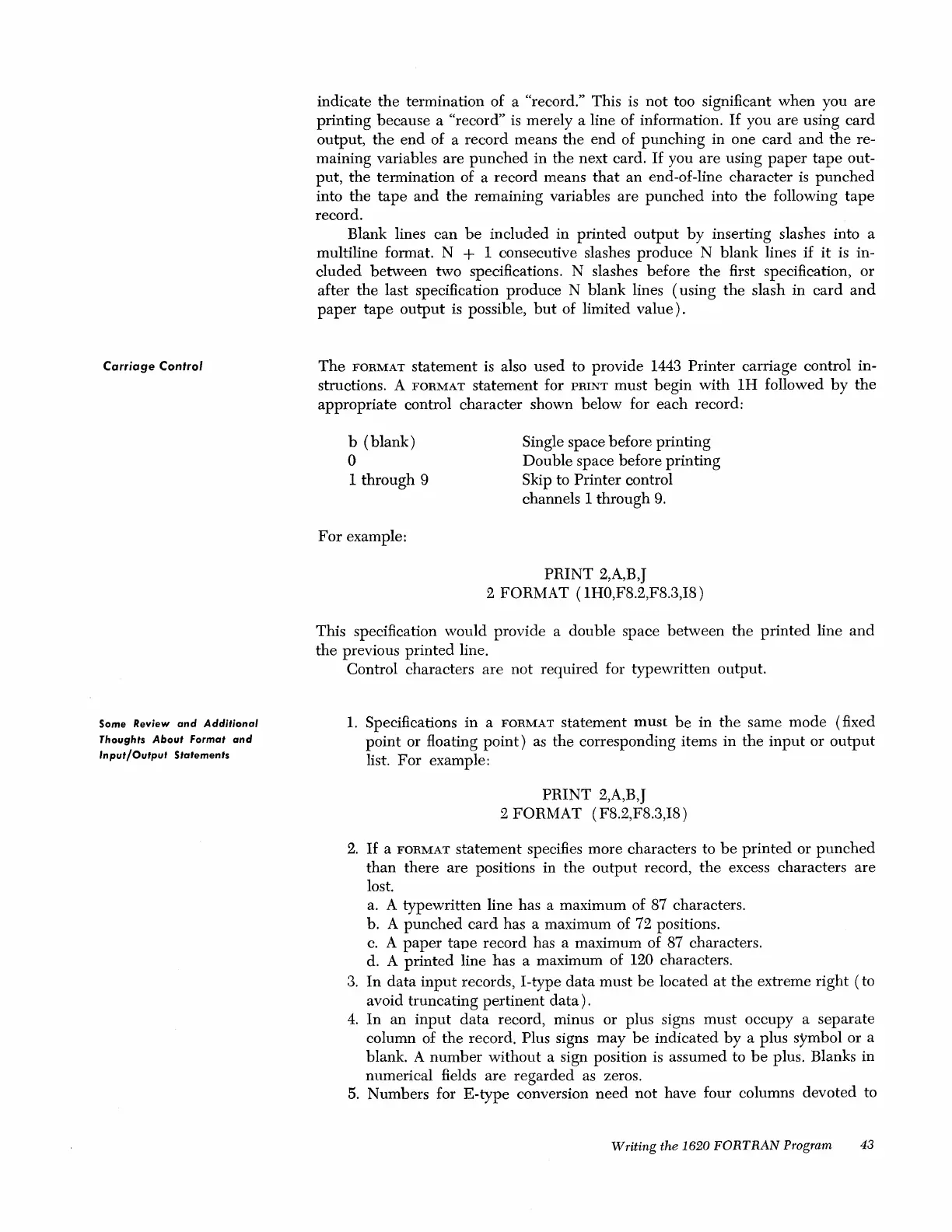Carriage
Control
Some
Review
and
Additional
Thoughts
About
Format
and
Input/Output
Statements
indicate
the
termination of a "record." This is
not
too significant
when
you
are
printing
because a "record"
is
merely a line of information.
If
you
are
using
card
output,
the
end
of a record means
the
end
of
punching
in one
card
and
the
re-
maining variables
are
punched
in
the
next card.
If
you
are
using
paper
tape
out-
put,
the
termination of a record means
that
an
end-of-line
character
is
punched
into
the
tape
and
the
remaining variables
are
punched
into
the
following
tape
record.
Blank lines
can
be
included
in
printed
output
by
inserting slashes into a
multiline format. N
+ 1 consecutive slashes
produce
N
blank
lines
if
it
is in-
cluded
between
two
specifications. N slashes before
the
first specification,
or
after
the
last specification
produce
N
blank
lines
(using
the
slash in
card
and
paper
tape
output
is possible,
but
of limited
value).
The
FORMAT
statement
is also used to provide 1443
Printer
carriage control in-
structions. A
FORMAT
statement
for
PRINT
must
begin
with
1H
followed
by
the
appropriate
control character shown below for
each
record:
b
(blank)
o
1
through
9
For
example:
Single space before
printing
Double
space before
printing
Skip to
Printer
control
channels 1
through
9.
PRINT
2,A,B,J
2
FORMAT
(1HO,F8.2,F8.3,I8)
This specification
would
provide a
double
space
between
the
printed
line
and
the
previous
printed
line.
Control characters
are
not
required
for
typewritten
output.
1.
Specifications
in
a
FORMAT
statement
must
be
in
the
same
mode
(fixed
point
or floating
point)
as
the
corresponding items
in
the
input
or
output
list.
For
example:
PRINT
2,A,B,J
2
FORMAT
(F8.2,F8.3,I8)
2.
If
a
FORMAT
statement
specifies more characters to
be
printed
or
punched
than
there
are
positions in
the
output
record,
the
excess characters
are
lost.
a. A typewritten line has a maximum of 87 characters.
b. A
punched
card
has a maximum of 72 positions.
c.
A
paper
tape
record has a maximum of 87 characters.
d. A
printed
line
has
a maximum of 120 characters.
3.
In
data
input
records, I-type
data
must
be
located
at
the
extreme
right
(to
avoid truncating
pertinent
data).
4.
In
an
input
data
record, minus or plus signs
must
occupy a
separate
column of
the
record. Plus signs
may
be
indicated
by
a plus symbol or a
blank. A
number
without
a sign position is assumed to
be
plus. Blanks in
numerical fields
are
regarded
as zeros.
5.
Numbers for
E-type
conversion
need
not
have
four columns
devoted
to
Writing the 1620
FORTRAN
Program 43
